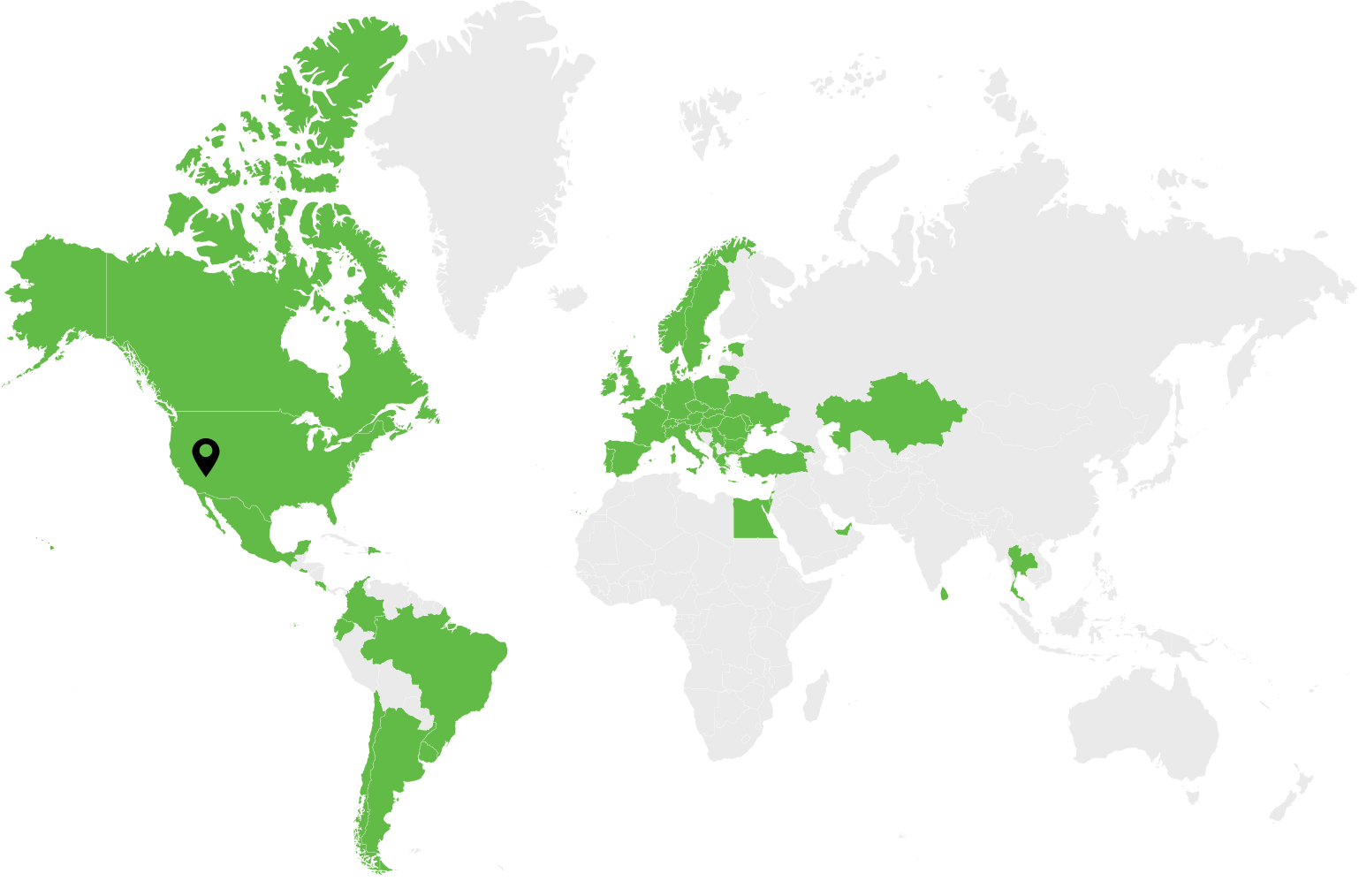Most of the key differences between enterprise software development and regular software development have to do with the complexity of system architecture, infrastructure, security, and IAM features.
Why is it good to know how they are different? You will be better prepared to establish those neural connections in your brain even before you approach the task so that you can minimize potential risks and optimize the entire workflow.
If you are working for a 500+ employee company that has an endless list of tech solutions built or purchased a dozen of branches across continents, this insight will lay a solid foundation for your Enterprise DX strategy.
Note: At its narrowest meaning, enterprise software development refers to creation of ERP, CRM, and SCM software—we will refer to a broader meaning, as in the definition below.
Let’s Define Regular and Enterprise Software Development
This brief outline of both terms will help cross the t’s in the technicalities down the path of subject matter discovery.
What Is Regular Software Development?
Software development is a multistage process of creating programs that can work in a browser or run on a physical server and designed to facilitate the execution of a certain business task by digitizing it into a functional software tool. A regular SDLC process involves design, build, deployment, testing, and maintenance stages performed by web designers, software developers, QA experts, and DevOps engineers.
What Is Enterprise Software Development?
Enterprise software development is a set of software engineering activities aimed to design, build, deploy, and integrate systems for larger corporations—to automate, optimize, cheapen, and increase the efficiency of processes for employees and clients alike.
Examples Of Enterprise Software
When taken at its narrowest meaning, multi-functional software for corporations are the most popular examples of such tools:
- Enterprise Resource Planning (ERP)
- Knowledge Management Software (KMS)
- Enterprise Content Management Software (ECM)
- Business Intelligence Software
- Customer Relations Management (CRM)
These examples are used in the finite, narrow meaning, as the broader definition suggests the entire ecosystems of tools and software used by a corporation, not just one multi-functional solution.
Enterprise Vs Regular Software Development: Key Aspects
In the majority of cases, regular Soft Dev is straightforward, as the product has a limited number of specific features, a well-defined audience, and a few competitors to learn from whose product you can buy and study to the dot.
When it comes to application development or building an ecosystem for a corporation, it’s likely to have multiple answers to every question. And choosing the best option based on the specific industry requirements is critical.
These are the pivotal differentiating features of an enterprise level software development:
1. Scale of Scope
Talking about the obvious, the grand scale of things is a major factor that defines your budgets, timelines, vendors, and choices in the process of establishing your Enterprise-Grade Software Ecosystem.
From which cloud service provider fits your needs best, to what architecture to choose for your customized pan-enterprise reporting solution, to the choice of software development partner—size is critical.
2. Complexity of Enterprise Software Development
Complexity is another differentiating point between large scale enterprise software development and regular Soft Dev.
All the characteristics below can be easily found in many existing enterprises, as their international tech ecosystem can still remain diverse, patched, and not synced:
- Multi-platform
- Multi-regional
- Multi-lingual
- Multi-currency
- Multi-measurable [imperial vs metric]
- Multi-channel
- Multi-vendor
- Multiple time-zone
- Multiple tax systems and percentages
- Hybrid and multi-cloud environments
- Legacy & cloud-native solutions
- Range of databases
- Mix of custom and vendor-developed solutions
These are just some of the top-level tiers where disparity and discord may reside, bringing in even more complexity to the already bulky system with numerous regions, departments, specialties, and legal systems.
3. Cloud Service Provider
Cloud adoption has gone into its mass adoption stage, and cloud computing is the new norm. According to Gartner, public cloud services end user spending will reach $600 billion in 2023.
While many of the smaller players are likely to opt for one cloud service provider, who best caters to their needs, bigger companies are likely to diversify and have a mix of AWS, GCP, Azure, and IBM products in their tech stack.
One cloud service provider helps to avoid any potential vendor lock-in disadvantages and also minimizes the chances of downtime. And if there is any unlikely global disruption experienced by one of the cloud providers, a contingency plan will switch critical volumes to an alternative supplier.
“Cloud is the powerhouse that drives today’s digital organizations. CIOs are beyond the era of irrational exuberance of procuring cloud services and are being thoughtful in their choice of public cloud providers to drive specific, desired business and technology outcomes in their digital transformation journey.”
Sid Nag, research vice president at Gartner
At the same time, a multi-cloud set up helps big corporations to get the best of all worlds. Some cloud service providers have great monitoring tools, some have unexampled packages for storing and archiving, others may have server centers right next to your head office. Such a setup allows for cutting cloud costs, and Cloud Cost Optimization has unparalleled saving potential leverage.
4. Internationalization and Localization [AKA World-Readiness & Globalization]
From keyboard shortcuts to character encoding, different writing direction [Hebrew and Arabic], paper sizes, currencies, system of measurements and telephone number formats, to tax systems and privacy laws—enterprise grade software solutions internationalization is a sizable task.
Enterprise solutions architects not only have to account for all these differences but also find the rules to streamline and convert them all for head office and stakeholder reporting.
5. Customization and Branding
When talking about custom software development for corporations, enterprise software developers, UX/UI designers, and architects will be guided by a set of corporate rules and preferences along industry and technical standards.
Branding is exhibited initially with a logo and specific colors and fonts to use in all design as well as printable reports.
Customization will take on a few shapes from dashboard report layout for specific country / department, to special notification setting for customers and specific API management set up to cater for some legacy element.
Both approaches can be applied to a varying extent to COTS [commercial off-the-shelf software] and custom-made technical solutions.
6. Scalability: Predictable and Guaranteed
Startups don’t know if they are going to be a commercial success, when it will happen, and how many users may want to try them at once.
With commercial organization of scale, the usage is monitored, measured, tracked, and recorded. In all probability, its seasonality is rather predictable and fairly precise forecasts can be performed.
Moreover, even if we are talking about ecommerce sales giants, who may have a successful marketing campaign going through the roof and putting too much pressure on their servers, those spikes can be accounted for in the next sales period.
TLDR: enterprise software engineering is more predictable in terms of cloud capacity consumption compared to regular processes. The larger companies have established business processes and demand has lots of history for accurate forecasting, which means that cloud cost optimization possibilities are endless and should be ongoing.
7. Reporting 101: More In-depth. More Intertwined. Ideally Real-Time
Reporting requirements for any enterprise software system are abundant and complex.
There are many KPIs to be reported daily, weekly, monthly, quarterly, or annually to different stakeholders.
Multi-region, multi-currency, and multi-time-zone environments present another set of hurdles and decisions to be made for a smooth HO view.
Creating a common mission center that accumulates all data from ERP, CRM, SCM, HRM, and BI tools, marketing software, and a corporate website is one earnest mission for any enterprise solutions architect.
The data can be flowing from different sources, as diverse in complexity and sophistication as Google Sheets and Google analytics.
Many corporations in the manufacturing, logistics, banking, and trading industries have real-time reporting as the must-have feature. This feature allows them to mitigate emerging worrying trends and grow on positive signals before the market does.
How to Hire Enterprise or Regular Software Developers
Truth be told, the only difference between a software engineer and an enterprise software developer is their experience with projects of different sizes.
If you have an experienced veteran Enterprise architect guiding the process, you can hire regular mid and senior developers for other processes. Anyway, they will perform their tasks according to the requirements set by the experienced manager.
Hiring a Regular Software Developer
You can hire in-house, freelance, or outsource your software engineering projects. The best platforms for hiring a software developer for smaller projects are Fiverr, Upwork, or Indeed.
If you are looking to get results with minimum micromanagement, you might consider hiring a software development partner like Dev.Pro. These vendors are usually well represented on Clutch, The Manifest, and Software World.
Hiring an Enterprise Software Developer
Hiring an Enterprise Software engineer on freelance sites is probably not the best idea.
You should post your vacancy on Indeed and Salary.
LinkedIn is your best senior-level head-hunting platform for a direct hire.
If you want to hire a star but want a solution served on a silver platter, while avoiding going through hundreds of candidates and screening dozens of shortlisted stars, you can also opt to contact a software engineering partner like Dev.Pro. In this case Clutch, The Manifest, and Design Rush are your best platforms.
Conclusion: Differences Between Enterprise and Regular Software Development
One key difference between the two types of projects here is that enterprise system development absolutely demands an experienced enterprise architect [and a senior solutions architect, too, in the best-case scenario] to drive the process.
The level of complexity and technical nuance demands a minimum of one decade of experience and dozens of projects under the belt from a solutions architect to be in a position to navigate such costly high-impact high-risk projects. Knowing how to prioritize processes, build out teams, select vendors, and align technological assets with business goals are just the tip of the iceberg for the required expertise.
As well, a thorough top-to-bottom inventory of all the available solutions, platforms, vendors, licenses, subscriptions, servers, and databases across all departments, branches, and countries is fundamental to the success of a digital transformation process of any enterprise.
Are you looking to modernize, migrate, replatform, merge, or integrate some of your company’s multiple technologies? Do you have a high software development standard and need to sustain the highest levels of security? Does your purchasing department demand that all technology partners be ISO certified? Speak to a Dev.Pro representative to see how we can enhance the efficiency of your tech ecosystem together.
FAQ
In its narrowest meaning, the term suggests tools such as ERP [Enterprise Resource Planning], CRM [Customer Relationship Management], and SCM [Supply Chain Management]. In its broader meaning, it’s an entire ecosystem of solutions used by large corporations.
The scale, level of sophistication, architectural complexity, need for globalization, complex security and IAM, and cloud service requirements are significantly more demanding for software development enterprise vs regular solutions.
Designing enterprise level architecture, purchasing the cloud services for an international corporation, developing modernization strategy for a tool, and migrating corporate databases to a cloud environment are examples of custom enterprise software development projects.


